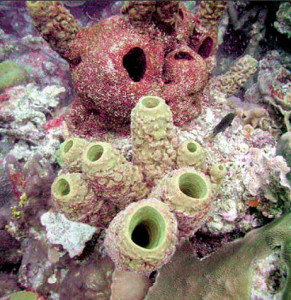
Anytime you snorkel or dive in the Florida Keys Ecosystem, you are almost guaranteed to see sponges. These unique creatures live just about everywhere: they live on the bottom in the seagrass beds, they attach to red mangrove roots and they grow on rocky areas at the coral reefs. They are even found living on the shells of crabs or mollusks. Sponges don’t seem to do much, so many people may be quick to pass them by, but they are very interesting and important animals. Sponges are animals in the phylum Porifera. The name Porifera comes from Latin, meaning “bearing pores.” Sponges are literally covered in pores, or holes, which they use to move water through their bodies. Most sponges have many small “incurrent” pores all over their bodies, and fewer larger “excurrent” pores. The incurrent pores allow water to flow into the sponge, and the excurrent pores move the water back out again. During this constant flow of water, the sponges are continually filtering. Bacterial cells, plankton and bits of organic matter suspended in the water will be filtered out by the sponge and consumed as food. This flow of water also allows the sponges to take in oxygen and to release waste.
While sponges are animals, they do not have a nervous system, brain or other organ systems; they do not even have a recognizable body shape like most animals do. Sponges’ shapes will vary depending on the species of sponge and the environment in which they live. One way to differentiate species of sponges is by color and texture; another is by looking at the shape and material of their spicules. Spicules are the microscopic framework of the sponges. They give rigidity and shape to the sponge, much like our skeletons do for us. These spicules may be made of calcium carbonate, silica or protein, and some are quite beautiful when viewed under a microscope. Along with filtering our waters, sponges can also provide valuable habitat for a variety of smaller organisms. Many sponges are hosts to small crustaceans like amphipods or shrimp. Larger sponges can even conceal small fish. Among the biggest sponges on our Florida reefs is the giant barrel sponge. Researchers at the University of North Carolina-Wilmington have documented giant barrel sponges more than 100 years old and have estimated the age of some of the largest individuals at more than 2,000 years.
Wherever they live, sponges fulfill a unique and important role in the ecosystem. Not only do they filter our water and provide shelter, they are also a food source for animals like loggerhead turtles. Next time you snorkel, look for the multicolored sponges you may not have noticed before. You can head out on a snorkel or dive boat, or even take a kayak or paddleboard into the mangroves to see these unique animals. You can even see them while swimming off the beaches at many of our Florida State Parks. Plan your visit at floridastateparks.org.
Liz Trueblood is a park ranger at John Pennekamp Coral Reef State Park.
